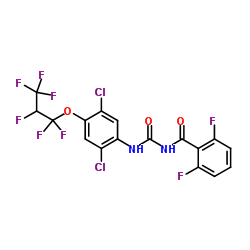lufenuron

lufenuron structure
|
Common Name | lufenuron | ||
|---|---|---|---|---|
| CAS Number | 103055-07-8 | Molecular Weight | 511.150 | |
| Density | 1.6±0.1 g/cm3 | Boiling Point | N/A | |
| Molecular Formula | C17H8Cl2F8N2O3 | Melting Point | 175 °C | |
| MSDS | N/A | Flash Point | 170 °C | |
| Symbol |


GHS07, GHS09 |
Signal Word | Warning | |
Use of lufenuronLufenuron is a lipophilic benzoylurea insecticide and a chitin synthesis inhibitor that can used for flea and fish lice control. Lufenuron inhibits moulting of arthropods[1][2]. |
| Name | lufenuron |
|---|---|
| Synonym | More Synonyms |
| Description | Lufenuron is a lipophilic benzoylurea insecticide and a chitin synthesis inhibitor that can used for flea and fish lice control. Lufenuron inhibits moulting of arthropods[1][2]. |
|---|---|
| Related Catalog | |
| References |
| Density | 1.6±0.1 g/cm3 |
|---|---|
| Melting Point | 175 °C |
| Molecular Formula | C17H8Cl2F8N2O3 |
| Molecular Weight | 511.150 |
| Flash Point | 170 °C |
| Exact Mass | 509.978424 |
| PSA | 67.43000 |
| LogP | 6.27 |
| Index of Refraction | 1.523 |
| Storage condition | 0-6°C |
| Symbol |


GHS07, GHS09 |
|---|---|
| Signal Word | Warning |
| Hazard Statements | H317-H410 |
| Precautionary Statements | P280 |
| Hazard Codes | Xi:Irritant;N:Dangerousfortheenvironment; |
| Risk Phrases | R43;R50/53 |
| Safety Phrases | S2-S24-S37-S60-S61 |
| RIDADR | 3077 |
| Packaging Group | III |
| Hazard Class | 9 |
|
Comparison of two ionic liquid dispersive liquid-liquid microextraction approaches for the determination of benzoylurea insecticides in wastewater using liquid chromatography-quadrupole-linear ion trap-mass spectrometry: evaluation of green parameters.
J. Chromatogr. A. 1356 , 1-9, (2014) Two dispersive liquid-liquid microextraction (DLLME) approaches including temperature-controlled ionic liquid dispersive liquid-liquid microextraction (TCIL-DLLME) and ultrasound-assisted ionic liquid... |
|
|
Assessing the potential for algae and macrophytes to degrade crop protection products in aquatic ecosystems.
Environ. Toxicol. Chem. 30(3) , 622-31, (2011) Rates of pesticide degradation in aquatic ecosystems often differ between those observed within laboratory studies and field trials. Under field conditions, a number of additional processes may well h... |
|
|
Use of a chitin synthesis inhibitor to control fleas on wild rodents important in the maintenance of plague, Yersinia pestis, in California.
J. Vector Ecol. 33(2) , 278-84, (2008) A study was designed to test the insect development inhibitors fluazuron and lufenuron for the control of fleas on sylvatic rodents as an adjunct to the control of plague. Historical data of flea burd... |
| lufenuron |
| N-{[2,5-Dichloro-4-(1,1,2,3,3,3-hexafluoropropoxy)phenyl]carbamoyl}-2,6-difluorobenzamide |
| FXFFYFXFFOR BG EG DMVMVR BF FF |
| Fluphenacur |
| 1-(2,5-Dichloro-4-(1,1,2,3,3,3-hexafluoropropoxy)phenyl)-3-(2,6-difluorobenzoyl)urea |
| rac-N-({2,5-dichloro-4-[(2R)-1,1,2,3,3,3-hexafluoropropoxy]phenyl}carbamoyl)-2,6-difluorobenzamide |
| (RS)-1-[2,5-dichloro-4-(1,1,2,3,3,3-hexafluoropropoxy)phenyl]-3-(2,6-difluorobenzoyl)urea |
| EINECS 410-690-9 |
| 8398291 |
| Benzamide, N-[[[2,5-dichloro-4-(1,1,2,3,3,3-hexafluoropropoxy)phenyl]amino]carbonyl]-2,6-difluoro- |
| N-[[[2,5-Dichloro-4-(1,1,2,3,3,3-hexafluoropropoxy)phenyl]amino]carbonyl]-2,6-difluorobenzamide |
| N-[[2,5-dichloro-4-(1,1,2,3,3,3-hexafluoropropoxy)phenyl]carbamoyl]-2,6-difluorobenzamide |
| MFCD00867616 |